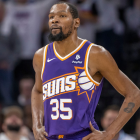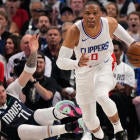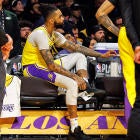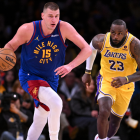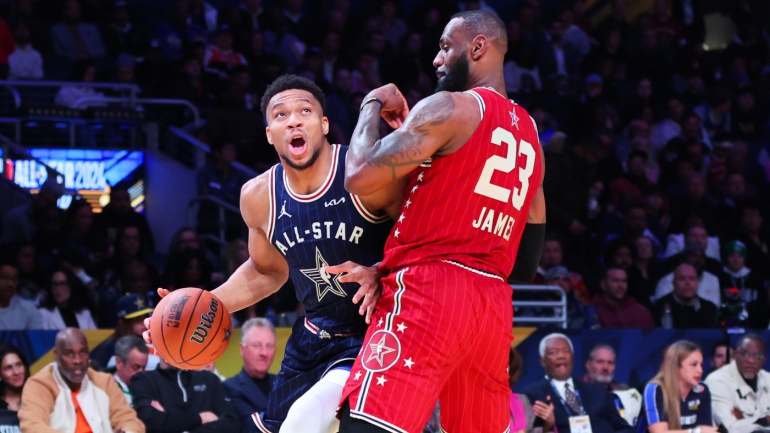
The NBA doesn't exactly seem optimistic about the future of the All-Star Game as an event. On a recent appearance on "King Charles," commissioner Adam Silver acknowledged that saving the game itself may not be possible. "I just think maybe we're past that point where we're going to play a truly competitive game," Siver said.
Everyone's heard the reasons for that by now. Players don't want to risk injuries in an exhibition game. They're run ragged doing sponsor events for the entire weekend beforehand. They want a midseason break. All of that is valid. The game's long-term future is very much in doubt when the commissioner himself acknowledges there may not be a way to convince players to take it seriously.
A popular idea to reinvigorate the event (and one I have supported) has been to turn it into a game between the 12 best American players and the 12 best international players. Silver addressed that notion in the interview, saying "we're going to look at US vs. international," but stressed that the disappointing 2024 event may have tempered the league's hopes for such a tweak.
The league is clearly still in the early stages of addressing these All-Star concerns. Silver hopes to turn the weekend into a "celebration of basketball," and pointed to the shootout between Stephen Curry and Sabrina Ionescu as a possible model for the future. But let's be realistic. The All-Star Game is a major television property. It isn't going to disappear overnight, no matter how poorly the product is received. If the commissioner of the NBA openly says that Team USA vs. Team World is under consideration, the league is probably going to do everything in its power to make such an event viable. Nothing else has worked. It makes plenty of sense to try.
But it's also a logistical nightmare for one simple reason: how would you pick the players? It seems simple on the surface. Build the best-possible 12-man rosters you could among American-born players and internationally-born players. This is a lot simpler on-paper than it is in reality for a variety of reasons.
Roster makeup is the most readily noticeable. The overwhelming majority of All-Stars born outside of the United States are big men. There are 15 active players born outside of the United States that have made an All-Star Game. Here's how they break down:
- Two of them, Shai Gilgeous-Alexander and Kyrie Irving, are traditionally guard-sized. Irving, however, has played for Team USA in the Olympics, so it is not clear which team he'd actually play for in this scenario.
- Three of them, Luka Doncic, Andrew Wiggins and Ben Simmons, are high-usage perimeter players.
- The remaining 10 are all most easily described as big men: Giannis Antetokounmpo, Joel Embiid, Rudy Gobert, Al Horford, Nikola Jokic, Lauri Markkanen, Kristaps Porzingis, Domantas Sabonis, Pascal Siakam and Nikola Vucevic.
Obviously, more great international players are coming. The majority of them, headlined by Victor Wembanyama, tend to be big men. These are not all traditional big men, of course. This group represents some of the most versatile players in basketball, and there would be a fun novelty in seeing how these giant lineups interact. If it goes poorly, though, the event would not be sustainable.
There isn't an easy solution to this problem. The NBA could use a positional quota system similar to the one that currently exists, but with seemingly so few deserving international guards, you'd not only have unworthy players in the game, but you'd be leaving out players who could credibly be considered among the 24 best in the league in that particular season.
This raises yet another concern. In just about every direction, whittling down the field becomes something of a collective bargaining nightmare. While All-Star berths are not tied to super-max eligibility like All-NBA selections are, they carry undeniable weight in contract negotiations.
Here's a perfect example: in 2019, D'Angelo Russell made an All-Star team averaging 21.1 points and seven assists on 43.4% shooting from the floor and 36.9% shooting from behind the arc. He proceeded to earn a full, four-year max contract in free agency. Across that contract, he averaged... 19.2 points and 6.4 assists on 43.5% shooting from the floor and 37% shooting from deep. The numbers were nearly identical, but he didn't make an All-Star Team. His next contract was a two-year, $36 million pact with the Lakers that nearly cut his salary in half. There were other factors involved there, but the basic point stands: making an All-Star team helps get players paid.
The NBA announced before the season that 125 total international players were on opening night rosters. NBA rosters include 15 full-time slots and two two-way slots for a total of 510 roster spots, meaning international players represented around 24.5% of the total player pool. That's an impressive number, but hardly a fair one from an All-Star perspective. International players would be competing against a smaller pool of total players for the same number of slots, and would therefore have easier access to the intangible financial value of making an All-Star Team.
Even as the union diversifies, it is still primarily made up of American players. It's hard to imagine the NBPA accepting a format that makes it harder for the majority of its constituents to earn All-Star selections. The obvious solution to this would be to expand All-Star rosters in order to guarantee a certain number of selections on both sides. Frankly, 15-man All-Star rosters are overdue. They are a closer reflection of actual NBA rosters today, and they would more closely align with All-NBA as a full-season honor. If there are 30 All-Stars and 15 All-NBA players, we can broadly call an All-NBA selection twice as meaningful. But Silver said during All-Star Weekend that the league does not plan to expand rosters for the game.
All of this is to say that actually building a traditional, 12-on-12 All-Star Game featuring half American players and half international would be a far more difficult task to pull off than it might seem. But Silver's comment about creating a "celebration of basketball" opens the door for alternatives.
Perhaps instead of expanding rosters, the NBA cuts them down. While the league would almost certainly still have to name typical All-Star rosters, perhaps the game itself is a shorter, five-on-five affair with no benches. That would highlight the absolute best players on both sides without demanding 48 minutes of action out of them. Perhaps there's a tournament format built on regional identities that could incorporate other parts of the world and different areas within the United States.
Watch any international competition and you'll see immediately why the thought of Team USA vs. Team World is so compelling. Whatever format All-Star Weekend eventually takes, incorporating it in some way would likely be a success. But building the entire weekend around an event that comes with so many inherent obstacles might not be feasible for the long term. Fortunately, the NBA appears to be considering every possible alternative as it attempts to fix its marquee regular-season event.















